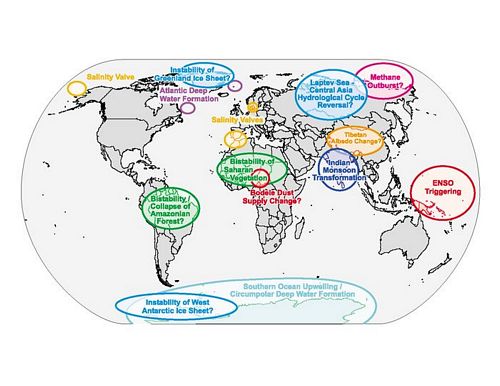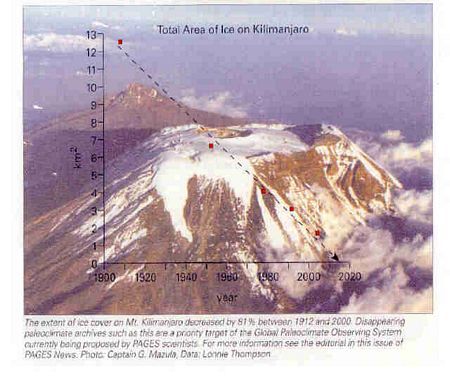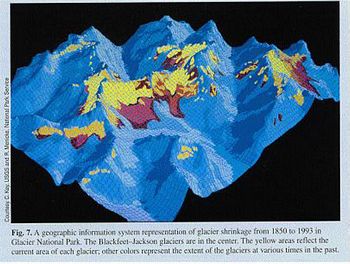 |
Click
on a Topic Below |
| Home » Impacts » Regional Impacts |
|
|
 |
|
| Consequences of Global Warming: Regional Impacts |
| The 1.5˚C to 6˚C global averagetemperature rise projected by IPCC for the current century may seemmodest, but as noted, it could imply quite serious impacts. What,really, might be the consequences? The most sophisticated climatemodels speak to a wide variety of possible impacts from globalwarming. Recall that a 6˚C dropin global average temperature is all that separates Earth’s presentclimate from an ice age. Fortunately, it does not appear that acomparable rise will have consequences as devastating as two-mile-thickice sheets over populated areas of the Northern Hemisphere (a commoncharacteristic of an ice age), but that doesn’t mean the consequencesof a few degrees or more of global warming will not be substantial anddisruptive with potential dangerous outcomes (see Mastrandrea and Schneider, 2004; also seetheir supplement). Global warming obviously meanshigher temperatures. But just how will the temperature rise bedistributed in time and in space? We’ve been looking mostly atthe global average temperature rise, but in fact, global warming willvary substantially from one geographical region to another, and it willhave different effects on night and day, winter and summer, land andsea, temperature and precipitation. Climate models have reached roughconsensus on many temperature-related projections. In general,temperature rises are projected to be greatest in the subpolar regions,and to affect the polar winter more dramatically than the summer. Similarly, nighttime temperatures are projected to rise more thandaytime temperatures. Land temperatures are projected to risemore than oceans, for the most part, influencing the patterns ofmonsoons and the life-giving rains (and deadly floods) theyengender. The broadest impacts of climatechange on human society are likely to occur in coastal areas, inagriculture and water supplies, although research has shown that evenareas considered untouched, like pristine sections of the Amazon rainforest, are being affected by climate change (see Laurance et al., 2004). Health effects,including heat stress (see Hayhoeet al., 2004) and the spread of lowland tropical diseases intocurrently unaffected regions, may also be significant, depending on theeffectiveness of adaptive measures to reduce the threat (e.g.,development of a malaria vaccine). Many projections have beenmade regarding the extent and dollar value of potential climate-relateddamages, as discussed in ClimatePolicy. One point that needs clarifying isthat of human carrying capacity. A 2004 Pentagon report on abruptclimate change (see ContrarianScience for a full account) states that carrying capacity"is the ability for the Earth and its natural ecosystems includingsocial, economic, and cultural systems to support the finite number ofpeople on the planet" (page 15). It goes on to say that "Abrupt climatechange is likely to stretch carrying capacity well beyond its alreadyprecarious limits.. As abrupt climate change lowers the world'scarrying capacity aggressive wars are likely to be fought over food,water, and energy. Deaths from war as well as starvation and diseasewill decrease population size, which over time, will re-balance withcarrying capacity" (page 15). While I agree that climate change doespose a real threat of lowering our population support systems, I alsothink that the concept of carrying capacity is not well-developed inthe Pentagon report. While the carrying capacity of a rat species is afunction of available resources, the same situation is not true forhumans. Human carrying capacity is not some limit governed byresources, but rather is a function of a given standard of living,which can be traded off against damage to nature. Humans aredistinguished from animals by their technological and organizationaladaptive capacities, and human carrying capacity depends not only onresources but on choices of standards of living, the side-effects ofthose choices, and humans' capacity to substitute alternate resourcesfor those that have been depleted. Natural ecosystems are likely to respond adversely to global warming; in fact, it is widely thought that natural systems will be less resilient than social systems. With temperatures changing much more rapidly than in most natural sustained global climatic shifts, temperature-sensitive plant species may find themselves unable to migrate fast enough to keep up with the changing climate. Even though their suitable habitats may shift by only a few hundred miles, a few hundred miles is a long way for a plant, and if species cannot reestablish themselves quickly enough, then they — and many of the animal species that depend on them — will go extinct, at least locally. Scientists have also identified various "geoboundaries", locations such as coastlines and mountaintops that are more prone than other areas to irreversible losses. If these areas become unsuitable for their present occupants or disappear altogether, extinction will be even more probable. A report by Still et al., 1999 and "Cloud forest agenda", a report commissioned by the United Nations Environment Programme (UNEP), for example, both lay out the problems associated with climate change, geoboundaries, and cloud forests. The worry is that cloud forests -- often situated at the peaks of mountains -- will be at risk of extinction as the climate warms because there will be nowhere for them to relocate (as they cannot move farther up the mountain to cooler climates if they're already at the top). This will affect not only the trees of the cloud forest, but all the plant and animal species within the cloud forest community (see Pounds and Puschendorf, 2004). The same fate could await manyanimal species (for early signs of this, see, for example, "North Sea faces collapse of its ecosystem").In a recent study, Thomaset al. (2004) assessed extinction risks for regions coveringabout 20% of the Earth's surface and found that, based on theirprojections, anywhere from 15%-37% of the species in those regionswould be "committed to extinction" by 2050. This is alarming giventhat, as discussed by Daily(1997), the goods and services that nature provides us could bevalued in the trillions of dollars, and many systems would bedevastated without them. About one third of our food, for example,comes from plants that must be pollinated by creatures such as birds,bees, flies, and bats. Without the service they provide, many plantswould face extinction and crops would become economically impractical,yet many pollinator species are threatened by combinations of land usechanges, introduced “exotic” species, pesticides, and climate change.Many are already beginning to relocate themselves to less hostileenvironments. These impacts could well lower resources available tohumans, meaning that maintaining any given population level wouldlikely reduce per capita standards of living, cause more disruption tonature, or both. However, there are still methodological debates overthe Thomas et al. work (see Buckley and Roughgarden, 2004; Harteet al., 2004; and Thuiller et al., 2004; and a reply by Thomas et al.), though I believethe synergy of habitat fragmentation and rapid climate change is athreat to biodiversity. This movement of plants and animalsis not just theory, as recent analyses have shown that birds are layingeggs a few weeks earlier, butterflies are moving up mountains, and thattrees are blooming earlier in the spring and dropping their leaveslater in the fall, among other impacts (see Root et al., 2003; Parmesan and Yohe, 2003; The Birdwatcher's Guide to Global Warming).Root et al. conclude that the most consistent explanation for theseobserved changes in environmental systems over the past few decades isglobal warming. This opinion was first assessed, and then echoed, byWorking Group II in the Third Assessment Report of the IPCC (2001b).Whether the regional climatic changes that seem to be driving theseimpacts are themselves anthropogenically-induced is more controversial.However, given that the responses observed are, in about 80 percent ofthe cases, in the direction that would be expected with global warming,Root and Schneider argue that global warming is the most consistentexplanation (see Chapter 1 of WildlifeResponses to Climate Change). Further research on this issue isunderway in the hopes that climatologists and ecologists can detectwhether the regional warmings that caused the biological responsesreported are human-induced. Recent work in progress by Terry Root,myself, and others strongly suggests anthropogenic climate change isindeed detectable in the plant and animal changes. More on this soon. Other weather-related projections ofthe effects of global warming include increased frequency of intenseprecipitation events, more and longer heat waves, more summer droughts,and fewer cold spells. The intensity of tropical cyclones(hurricanes and typhoons) is likely to increase, although it is lessclear whether the frequencies or locations of these storms willchange. Hail and lightning are also likely to occur moreoften. The large-scale Pacific Ocean fluctuation known as the ElNiño/Southern Oscillation could become more persistent, whichwould have a substantial climatic impact on the Americas. Allthese projected changes will impact agriculture and may increaseflooding and erosion, with reverberating effects on health and on theinsurance industry (see Walker, 2003 and Coleman, 2003). It appears that theseprojections are already becoming reality. As discussed in the IPCCSynthesis Report (2001), after accounting for inflation,weather-related economic losses have increased tenfold since the 1950s.While part is likely due to growth in wealth and population, part islikely climate-related. For more on climate change financial damageestimates, see ClimatePolicy. As shown in Projected Effects of Global Warming,the confidence level in these projections ranges from medium(likelihood between one-third and two-thirds) to high (chances greaterthan two-thirds). Keep in mind, however, that the probabilitiesgiven in Projected Effects of Global Warming are notbased on conventional statistical analysis because they refer to futureevents that are not expected to follow past patterns, and the futurehasn’t occurred yet! Rather, these are subjective oddsbased on scientific judgment that is as expert as current understandingpermits. Not surprisingly, that subjective element encouragessome participants in the political process to attempt to discount theseprobability estimates (see Schneider and Kuntz-Duriseti, 2002 for morediscussion on uncertainties and methods to deal with them). One final note on the issue ofclimatic impacts: Like abatement, adaptation also varies across regionsand brings up complex issues of justice and fairness. The socioeconomicconditions driving emissions also help to form the adaptive andmitigative capacities of various countries, meaning that the countriesthat have contributed the most to global emissions (see a graphic fromthe Hadley Centre on the Guardian website, "Carbon dioxide emissions"; a graphicabout U.S. CO2 emissions; and aGuardian article titled "Roadto Ruin: How America is Ravaging the Planet") will have higheradaptive capacities. Less developed countries and disadvantaged groupswithin countries, on the other hand, will tend to have lower adaptivecapacities, as they are oftentimes limited by financial, technological,and governmental constraints. Suffering in Bangladesh due to rises insea level or more intense storms is made worse by the nation's lack ofadaptive capacity, given its geographic, economic and social conditionsrelative to, say, Holland, a country for which adaptation to sea levelrise is much more feasible and likely. The International Red Cross/ RedCrescent estimates that people caught in natural disasters inlow-income countries are four times more likely to die than peopleconfronted by natural disasters in high-income countries. The problemwith this inequality is that climate change promises to bring an unevendistribution of consequences; the hotter, poorer nations (the samecountries that have less adaptive capacity) will be more vulnerable toclimate change damages and more in need of successful adaptation. Thiswill be especially true if and when thresholds are exceeded andsurprise events are triggered. The Ecological Footprint Accounts, published in a report titled "Ecological Footprint of Nations" by Redefining Progress, provide us with a good way of considering adaptive capacity. A country's ecological footprint is basically the land area required to support it. Unsurprisingly, the US has the world's largest footprint -- 9.57 hectares per capita -- whereas developing nations like Bangladesh and Mozambique have per capita footprints of 0.53 hectares. 1.88 hectares is considered sustainable in that study. While this assessment is not based solely on CO2 emissions. Redefining Progress says that much of the industrialized nations' ecological impacts are due to fossil fuel usage, and shifting to renewables can significantly reduce footprint size. Like emissions levels, footprint size appears to correlate highly with adaptive capacity, but ironically, reducing the footprint size can now help developed countries to experience many benefits, including environmental health, economic vitality, and social equity. Abatement also brings up equity issues in terms of the trade-off between adaptation and abatement. It is often assumed, particularly in a cost-benefit analysis (CBA) framework, that mitigation and adaptation can be viewed as competitive strategies to deal with climate change, but we must first consider the potential implications of the oft-stated trade-off. Suppose it were cheaper for an industrialized, high-emitting nation in the political North to adapt than to mitigate. If that nation chose only to adapt, it would likely be detrimental to a poorer, less adaptable country in the South. Simply comparing mitigation and adaptation costs and aggregating the values across all nations is a "one dollar, one vote" aggregate prescription, and it clearly has serious equity implications. The low-cost option for one country is most like not synonymous with the low-cost option for its neighbors or the world at large. In addition, technically speaking, in a cost-benefit framework, the mitigation/adaptation trade-off consideration would not be meaningful over time, since mitigation costs in a CBA are weighed against the benefits of avoided climate damages and not against adaptation costs. Adaptation can subtract from climate damages, which constitute much of the "trade-off", but at low levels of climate change, adaptation costs are likely to be low, whereas first steps in abatement may be higher (presuming perfect markets and no "no regrets" options). However, as greenhouse gas concentrations increase and climate change intensifies, adaptation costs will likely rise, and adaptation may not even be feasible for large or irreversible climate changes. As Grubb, 2004 states, "There are also impacts that can hardly be mitigated by adaptation. Some coastal deltas and swamp habitats may be impossible to protect against rising sea levels. Nothing [within the realm of adaptation] can stop the melting of mountain glaciers, the loss of mountain ecosystems, or the bleaching of coral reefs due to warmer waters. Probably not much can be done to prevent some other ecosystems and species dying out as climatic zones shift." In this light, it is clear that adaptation is an important measure, but it is not a substitute for abatement. An adapt-only strategy will likely just postpone trouble for the future. In the Regional adaptive capacity tablebelow, the IPCC authors summarize a comprehensive list of potentialclimate change impacts for most of the world's regions and economicsectors. As depicted in the table, damages may be asymmetrically feltacross the developed/developing country divide as climate changebecomes more of a problem in the future, eliciting questions ofinter-country and intergenerational equity. If mitigation measures arepostponed, as the income gaps between populations and countries growlarger, climate change is likely to increase world- and country-scaleinequity, both within the present generation and between present andfuture generations, particularly in the developing countries. Whilethis may not move some traditional advocates of aggregate cost-benefitmethods, it drives the realpolitik of international climatepolicy negotiations (see a chapter by Baer, and a chapter by Agarwal, in Climate Change Policy: a Survey, 2002). Table — Regional adaptive capacity,vulnerability, and key concerns (relevant sections of IPCC 2001b for each example are given insquare brackets). a,b (source: IPCC 2001b, table SPM-2).
a Because the availablestudies have not employed a common set of climate scenarios andmethods, and because of uncertainties regarding the sensitivities andadaptability of natural and social systems, the assessment of regionalvulnerabilities is necessarily qualitative. b The regions listed inthis table are graphically depicted in Figure TS-2 of the TechnicalSummary of IPCC, 2001b. Many regional effects have the potential to further alter the climate on a large scale, as depicted in the figure below. Figure— Potentially sensitive ‘switch point’ areas in which local effects might trigger larger-scale changes. The chart shows regions in which specific local phenomena may result in points of sensitivity for larger-scale and possibly rapid changes in regional or global climatic conditions. (Source: Grubb 2004, from J. Schellnhuber and H. Held, adapted from ‘How Fragile is the Earth System?', in J. Briden, and T. Downing, T.(Eds.), Managing the Earth: the Eleventh Linacre Lectures, Univ. Press, Oxford, 2002). The climate policy community is therefore faced not only with the need to estimate the impacts of a wide range of plausible climatic futures, but also with the imperative of estimating the relative adaptive capabilities of future societies so as to assess the equity implications of the consequences of global warming. This complicates the negotiations of solutions, as many of the typically proposed mitigative activities could slow the economic growth rates of those very countries that need to build adaptive capabilities by growing economically (e.g., IPCC, 2001c). Yet, if these countries are allowed to emit unabated amounts of greenhouse gases, the risks of severe climate change impacts, including irreversibilities, will increase. The best way to approach this dilemma is to assess the range of possible climate change outcomes, their costs, and the distribution of those costs, and then to weigh those impacts against the costs and benefits of a host of mitigation options carried out in various countries. This must be done keeping in mind that there are large inequities in access to resources that make it difficult to achieve agreements protecting the global commons. Side payments or other schemes to redress the inequity issue will have to be part of future climate policy negotiations if they are to be acceptable to a majority of nations. ConclusionThe absence of highly confidentassessments about "dangerous" climate change and the impacts of climatechange in general (see also "Assessingthe science to address UNFCCC Article 2") is likely to remaina feature of this policy debate landscape, and thus there is acritical need for a public literate in how climate science works, whatsubjective probabilities are, and how effective risk-managementtrade-offs can be made across time and income groups. It is my hopethat this website, the literature cited, and its external links willhelp in that process. Figure — What will happen to the Snows of Kilimanjaro? (source: PAGES). |
| | |
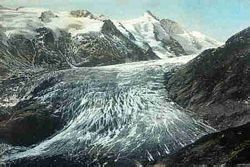 | 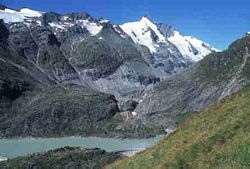 |
Above: Pictures of Shrinking Glaciers — see Researchers Track Glacial Melt with Old Photos, NewTechnology. Source: http://www.gletscherarchiv.de.
Figure —A geographic information system representation of glacier shrinkage from 1850 to 1993 in GlacierNational Park. The BlackfeetJackson glaciers are in the center.The yellow areas reflect the current area of each glacier; other colorsrepresent the extent of the glaciers at various times in the past.(Courtesy: C. Key, USGS and R. Menicke, National Park Service) (Source: USGS - Understanding Climate Change Effects onGlacier National Park's Natural Resources)
Links
- IntergovernmentalPanel on Climate Change
- Climate Change: Causes, Impacts and Uncertainties,Testimony of Dr. Stephen Schneider, 10 July 1997.
- Hearing on the Case for Climate Change Action -Testimony of Dr. Stephen Schneider. 1 October 2003.
- Climate Change 2001: Synthesis Report
- IPCC, 2000: Emissions Scenarios - A Special Reportof Working Group III
- TheNational Climatic Data Center
- U.S. Global Change Research Program: ClimateVariability and Change
- Exploratorium— Global Climate Change
- Understanding the Global Water Cycle — NASA
- NationalSnow and Ice Data Center/State of the Cryosphere
- NationalOceanic and Atmospheric Administration (NOAA) Arctic Theme Page
- CSIRO Atmospheric Research - Climate Change
- TyndallCentre for Climate Change Research
- United States Environmental Protection Agency (EPA)Global Warming Site
- GlobalWarming: Early Warning Signs - Union of Concerned Scientists
- Intergovernmental Panel on Climate Change. WorkingGroup II: Impacts, Adaptation and Vulnerability
- Eco-portal's website on climate change impacts
- Greenpeace Climate Impacts Database, and Search Engine
- Frontiersin Ecology and the Environment
- The Pacific Institute - Climate Change and Water
- BBC: Warning From the Wild: Hot Topics
- Union of Concerned Scientists
- Coral Reef Bleaching
- United States Geological Survey (USGS)/Global ChangeResearch in Biology
- U.S. Global Change Research Program: NationalAssessment of the Potential Consequences of Climate Variability andChange
- Dialogue on Water and Climate
- American Bird Conservancy (Climate Change andBirds)
- Impactsof Climate Change from climate.org
- ClimateInformation Project (Climate Weather Impacts}
Articles
- United States Geological Survey (USGS)/Status andTrends of the Nation’s Biological Resources (Schneider and Root)
- Kinzig, A.P., S. Carpenter, M. Dove, G. Heal, S.Levin, J. Lubchenco. S.H. Schneider, and D. Starrett, 2000: Natureand Society: An Imperative for Integrated Environmental Research.Executive Summary, NSF Meeting, June 5-8, Tempe, Arizona, November2000, 6 pp
- Kinzig, A.P., J. Antle, W. Ascher, W. Brock, S.Carpenter, F. S. Chapin III, R. Costanza, K.L. Cottingham, M. Dove, H.Dowlatabadi, E. Elliot, K. Ewel, A. Fisher, P. Gober, N. Grimm, T.Groves, S, Hanna, G. Heal, K. Lee, S. Levin, J. Lubchenco, D. Ludwig,J. Martinez-Alier, W. Murdoch, R. Naylor, R. Norgaard, M. Oppenheimer,A. Pfaff, S. Pickett, S. Polasky, H.R. Pulliam, C. Redman, J.P.Rodrigez, T. Root, S.H. Schneider, R. Schuler, T. Scudder, K. Segersen,M.R. Shaw, D. Simpson, A.A. Small, D. Starrett, P. Taylor, S, van derLeeuw, D.H. Hall, M. Wilson (eds.), 2000: Nature and Society: An Imperative for IntegratedEnvironmental Research, NSF Workshop, June, Tempe, Arizona, inpress.
- Rosenzweig, C., F.N. Tubiello, R. Goldberg, E.Mills, J. Bloom, 2002: “Increasedcrop damage in the US from excess precipitation under climate change”
For more climate information, see:
